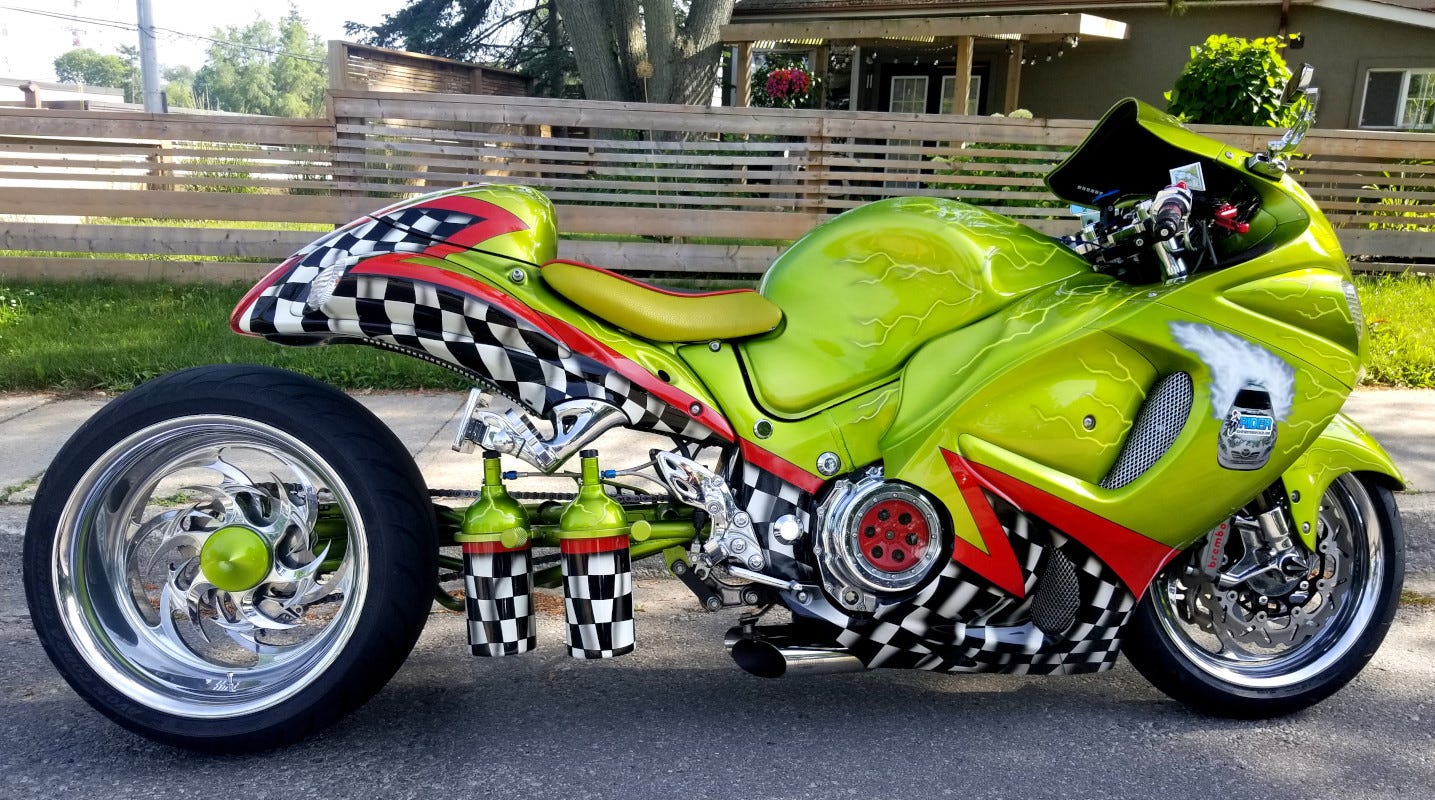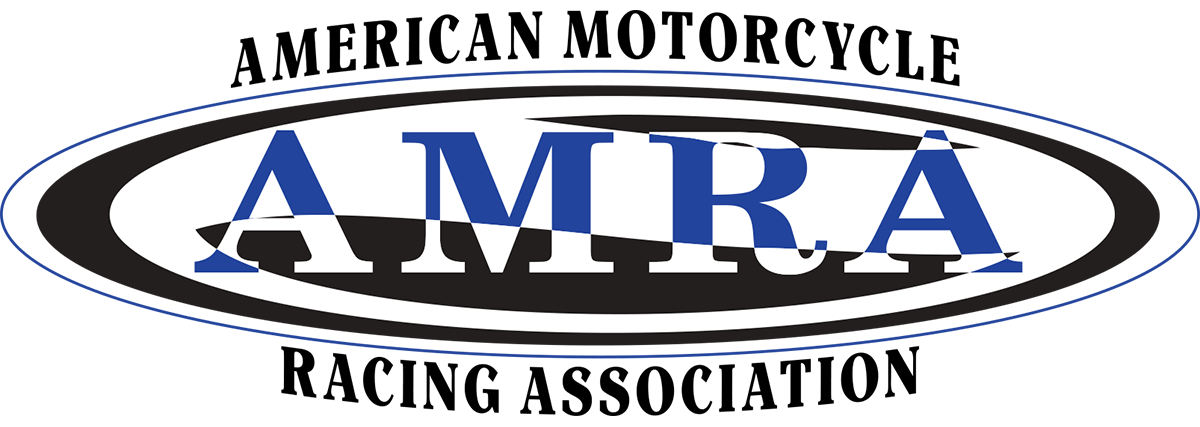NOS = POWER
NOS is not a gas, it's a non-flammable oxidizer that many motorcycle riders use for an adrenalin rush to squeeze out some extra ponies. Hit the switch, turn the throttle and go...
Birth of NOS
In the 1970s, nitrous oxide started gaining attention in the automotive racing world. Mike Thermos and Dale Vaznaian, two successful automotive technicians and racers, saw the potential of nitrous oxide and founded Nitrous Oxide Systems, Inc. (NOS) in 1978. They didn't invent nitrous oxide but perfected its use, making it a reliable and efficient performance enhancement.
Above: twin cans of nitrous on Gen2 Hayabusa (HardRider Green Hornet)
Nitrous oxide systems are now a staple in motorsports. They work by injecting nitrous oxide into the engine's intake manifold, providing extra oxygen to the combustion process. This allows for more fuel to be burned, resulting in increased power output. Modern nitrous systems are available for both carbureted and electronically fuel-injected engines, with basic dry kits costing as little as $400.
Many sportbikes such as the Suzuki Hayabusa, the Kawasaki ZX-14 and others can perform a 1/4-mile drag race in the 9-second range or even better with little to no modifications.
Racing Organizations
The largest drag racing organization is the NHRA, which has over a hundred different tracks where motorcycles can be raced in seven different divisions across the country.
AMA Dragbike is an eight race series that travels all over the county with 3 races in Georgia and a race in each of the following states: Tennessee, New Jersey, Ohio, Michigan, and Indiana. This is the most popular racing series with motorcycles, some of which travel over 250 mph in a quarter mile race. There are five racing classes dedicated to the sportbike drag racing. Some of these classes feature a bracket racing format while others are heads up racing classes where the first racer to the finish line wins. Most fans feel that the most exciting class to watch is the Pro Street class, where sportbikes can reach over 200 mph in the quarter mile.
The MiRock racing series is an all motorcycle drag racing series run at Rockingham Dragway in Rockingham, North Carolina and Maryland International Raceway in Budds Creek, Maryland. This series runs eight races a year between these two tracks. Their main focus is on sportbike motorcycle drag racing and they have eight different racing classes available by racers with the proper equipment.
Racing Classes
The most basic racing class is the bracket racing class, Street ET. Each motorcycle in this class must have a street tire and feature no wheelie bars. Some of these bikes have minor modifications such as having been lowered or featuring an air shifter to change gears. Each rider submits a "dial in" time before the race (the predicted time he/she will run), and the racer running the closest to their dial in and getting to the finish line first without running under their dial in wins. Reaction time is important, especially the closer a racer gets to the finals. Bracket racing is a relatively inexpensive and easy way to get into drag racing a sportbike. "This is a great class to come start in and once was the stomping grounds for many racing of the “Pro” riders today".
Another popular classes is "Pro Street", which features some bikes as fast as the upper six-second range, street tire motorcycles with no wheelie-bars traveling down the track at over 200 mph. "The Pro Street class is a professional heads-up class that contests the ultimate in street-legal motorcycles" (Series Information). These bikes appear similar to ordinary street bike, but have a vast array of performance-enhancing products, turbo or nitrous oxide for example. The Pro Street motorcycles are often just as fast as a pro stock motorcycle but resemble more of a street appearance with working headlights and taillights along with street tires.
Here are some 2024 motorcycle drag racing events:
America Motorcycle Racing Association (AMRA)
Includes the Cajun Nitro Nationals, Maryland Nitro Nationals, Ohio Nitro Nationals, Michigan Nitro Nationals, Thunder Valley Nitro Nationals, Clay Jones Memorial Nitro Shootout, and the 33rd Jim McClure Nitro World Finals
Legends Nitro Series
Includes the March Meet, Ignitor Nitro Opener, NHRA Thunder Valley Nationals, and Wally Parks NHRA Nostalgia Nationals
Professional Drag Racers Association (PDRA)
Includes the East Coast Nationals, Mid-Atlantic Showdown, American Doorslammer Challenge, and North vs. South Shootout
NHRA Mission Foods Series
Includes the Pro Stock Motorcycle All-Star Callout, 55th annual NHRA Gatornationals, Countdown to the Championship playoffs, and Road to the Championship playoffs
Types of Nitrous Oxide Systems
There are two main types of nitrous oxide systems used in drag racing: dry and wet systems.
Dry Nitrous System: This system only controls the delivery of nitrous oxide. The fuel is delivered through the existing fuel system1. Dry systems are typically used on late-model vehicles with throttle bodies and can provide a horsepower increase of about 100-150 HP.
Wet Nitrous System: This system introduces both nitrous oxide and fuel into the engine. The nitrous and fuel mixture is introduced before the throttle body, causing the intake manifold to become "wet" with fuel. Wet systems are suitable for both carbureted and EFI (Electronic Fuel Injection) engines.
NOTE: Nitrous is NOT Nitro Methane. Nitro methane is a fuel used by top class Drag bikes/cars and is in no way similar or linked to nitrous oxide. In fact they couldn't be more different, as nitro methane is a flammable fuel, while nitrous oxide is a non-flammable oxidizer.
A wet nitrous system is a popular method for adding horsepower to older carbureted engines. Unlike dry systems, wet systems introduce both nitrous oxide and additional fuel into the intake manifold, ensuring a proper air-fuel mixture for optimal combustion.
Components Required
Nitrous Bottle: Stores the nitrous oxide under high pressure.
Nitrous Solenoid: Controls the flow of nitrous oxide.
Fuel Solenoid: Controls the flow of additional fuel.
Nitrous Plate: Installed on the intake manifold, it has jets for nitrous and fuel.
Fuel Line Adapter: Connects the fuel solenoid to the fuel line.
Relay and Switches: Controls the activation of the solenoids.
Pressure Gauge: Monitors the nitrous bottle pressure.
Differences Between Wet and Dry Systems
Wet systems add fuel through the nitrous solenoid, ensuring a proper mixture. Dry systems rely on the existing fuel system to provide additional fuel.
Wet systems require both nitrous and fuel solenoids, while dry systems only need a nitrous solenoid.
Wet systems are suitable for carbureted or fuel injected engines, whereas dry systems are typically only used with fuel-injected engines.
Safety and Risks
A dedicated fuel pump may be required to ensure sufficient fuel pressure.
The flow of gas and nitrous is controlled by the solenoids, which are activated by the switches and relay.
Potential Dangers: Improper installation or tuning can lead to lean conditions, detonation, and engine damage. Always start with a conservative nitrous shot and gradually increase.
Filling Nitrous Oxide Bottles
Filling nitrous oxide bottles requires careful attention to safety and proper equipment. Here's a step-by-step guide:
You'll need a mother bottle (a larger nitrous bottle), a fill station kit, a scale, a bottle heater, and a cooler with ice.
Heat the mother bottle using the sun or a bottle heater and chill the nitrous bottle in a cooler with ice.
Connect the lines from the mother bottle to the nitrous bottle using the ball valve and filter. Open the valves on both bottles and monitor the scale until the desired weight is reached2.
Close the valves, disconnect the lines, and weigh the nitrous bottle again to confirm the amount of nitrous.
Basic Nitrous Setup & Installation
The nitrous oxide injection system begins with a connection to the nitrous bottle containing pressurized liquid nitrous oxide. This connection goes to the nitrous solenoid. This solenoid is normally closed, but opens when the throttle position sensor (TPS) switch senses that the nitrous system is armed and the engine is at wide-open throttle. Once this solenoid opens, the nitrous is delivered to the nitrous nozzle via a flexible delivery line. The amount of nitrous that is injected through the nozzle is adjustable by means of a metering jet installed in the nozzle itself. This metering jet allows for easy changes in horsepower settings. While the nitrous is being injected, additional fuel must be added by an aftermarket power programmer fuel controller.









